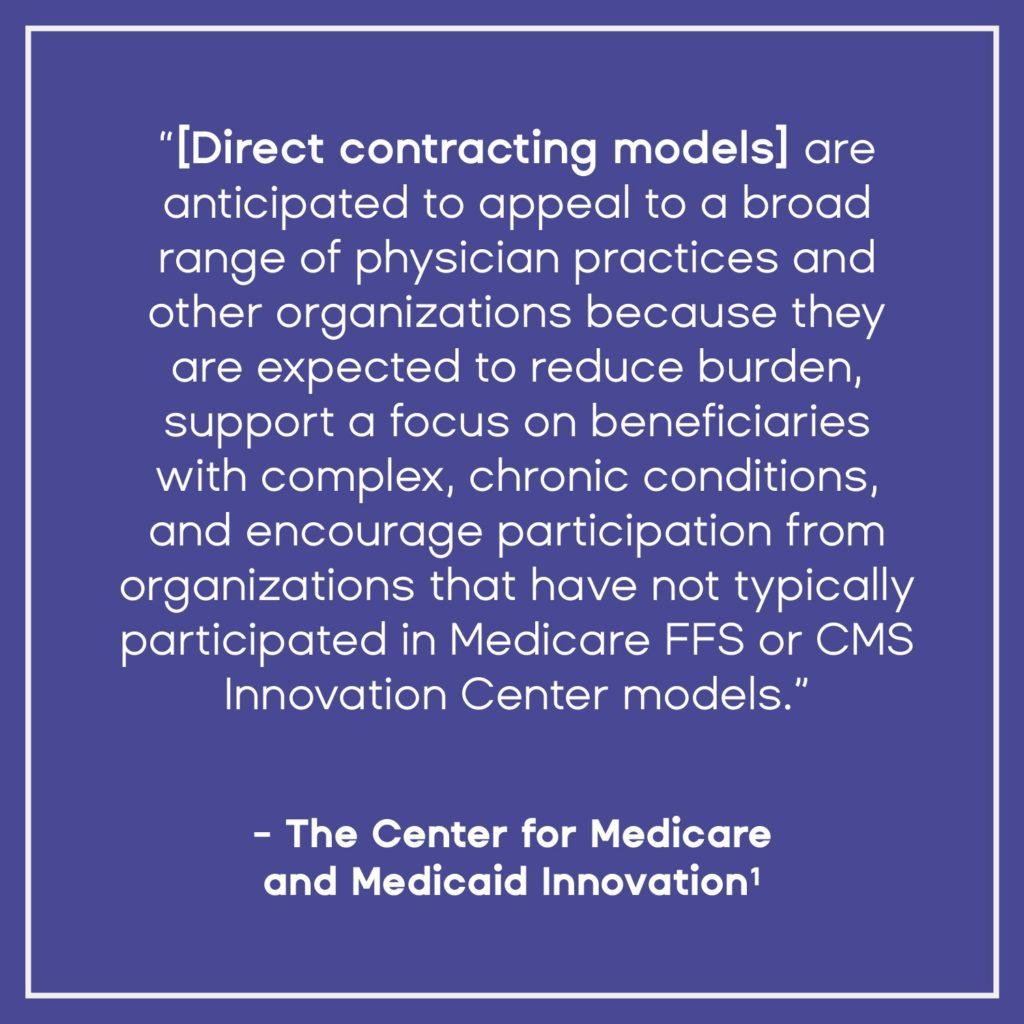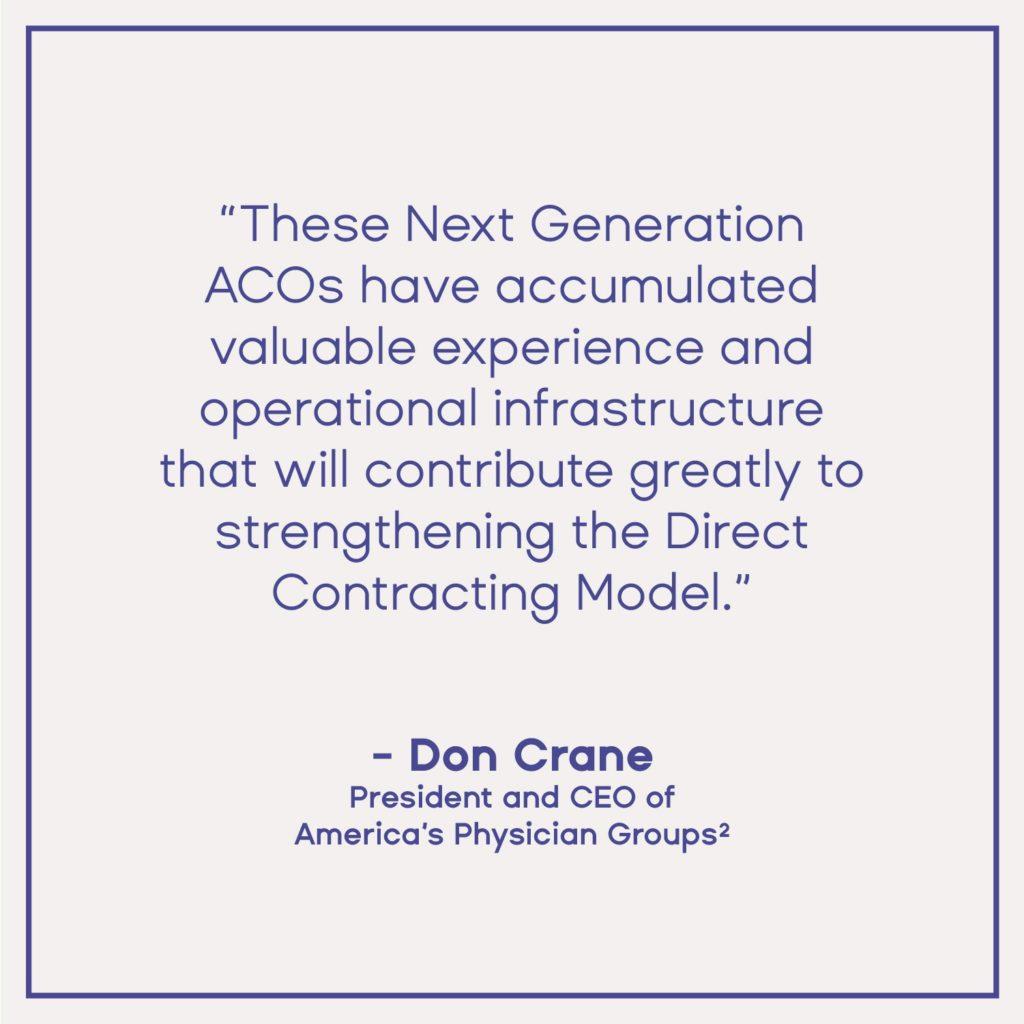Over the last several years, the Centers for Medicare and Medicaid Services (CMS) has increasingly invested in innovative Medicare programs. An exemplary model is the Medicare Shared Savings Program, which has a primary goal of reducing costs while enhancing the value of care and patient outcomes. Accountable care organizations have also been a successful model in this regard. CMS is now taking additional steps to increase participation in these shared savings models, with Direct Contracting being the latest iteration.
Both accountable care organizations and direct contracting entities take on increasing amounts of risk in caring for patients, empowering physicians operating in either of these programs to share in the savings they help generate. In other words, high-value care that improves outcomes at lower costs allows organizations and providers to receive additional revenues. Likewise, poor or low-value care that increases costs and utilization of services places providers and organizations at risk of owing repayments to Medicare, where penalties are imposed that are proportionate to the excessive costs encountered. Despite these commonalities, Direct Contracting has some appealing qualities that will likely favor its ongoing adoption. With this in mind, it’s essential providers have a solid understanding of their options.
Comparing ACO to DCE Shared Savings Programs
In essence, an accountable care organization is simply a network of providers working together to improve quality and better-valued care. The goal is to provide the right care at the right time in the right place for Medicare Part A and B patients. Any shared savings that result are paid to the ACO and then to ACO providers thereafter. The same is true for potential shared losses. Due to this arrangement, the ACO plays a role in encouraging providers to coordinate care and to implement higher value practices. The same is true of Direct Contracting Entities, but the ways in which payments are facilitated and care is rewarded differ.
Direct Contracting affords the opportunity to compensate providers via a fully capitated monthly payment. This fixed payment is proportional to the size and riskiness (disease burden) of the physician’s individual patient panel and the regional cost of providing healthcare services.
This flat monthly payment differs from most ACO models, which retain the fee-for-service payment structure. Unlike ACOs, DCEs also receive a care management loan that is debited against future savings, allowing them to invest in the tools and care management infrastructure necessary to generate savings without having to wait for savings 18 months after a given performance year starts. This can have cash flow implications for individual providers.
There are some additional differences between accountable care organizations and direct contracting entities as well. In the context of participating in ACOs, providers must deal with more complex data reporting requirements, which can be time-consuming and burdensome. In Direct Contracting, however, Medicare claims information and patient satisfaction surveys are the primary requirements. Likewise, Direct Contracting allows providers to access a greater percentage of the shared savings if they choose to take on greater risk. These are notable advantages that Direct contracting offers that some providers find appealing.
Choosing the Right Direct Contracting Option
Direct Contracting allows providers greater independence in determining which shared savings options might be best. Naturally, different providers serve different populations and have different levels of experience with taking on risk. For this reason, CMS has a few different Direct Contracting models from which to choose, varying based on the benefits a given DCE elects to include in its offering and the level of risk assigned.
There are two main risk sharing models within Direct Contracting that providers may consider. The professional DCE risk track splits savings and losses 50/50 with CMS, allowing less mature organizations to participate without full exposure to the total cost of care. The global DCE risk track provides full exposure to the total cost of care and remits all savings back to the DCE and its providers, which can be appropriate for mature organizations and providers who already have extensive experience with ACO metrics and coordinated care systems. Providers who specifically serve high-needs populations may be best served in a high-needs DCE, which can participate in either the professional or global risk tracks, but weight different factors to determine savings versus losses. CMS developed these varied options in an effort to attract a wider range of program participants.
Direct Contracting Shared Savings Models Likely to Persist
The Direct Contracting model is the latest program that CMS has released. With each program, CMS has incentivized organizations and providers to accept higher risks related to delivering efficient patient care and move more fulsomely into a value-based care paradigm. In order to achieve lower costs and better-value care, accountability is needed. Likewise, so are rewards and penalties. In this regard, both ACOs and DCEs are attractive. But DCEs have more to offer including more stable monthly payments, the ability to utilize anticipated future savings in the present, and flexibility in delivering appropriate care. These features are intentional by design in an effort for CMS to broaden participation in shared savings programs. For all of these reasons, Direct Contracting looks to be a model that CMS will embrace for the foreseeable future.
1 Hagland, M. (2021). CMS Declines to Extend Next Gen ACO Model, But Invites ACOs to Join Direct Contracting. Healthcare Innovation Group. Retrieved from https://www.hcinnovationgroup.com/policy-value-based-care/alternative-payment-models/news/21224080/cms-declines-to-extend-the-next-gen-aco-model-but-invites-acos-to-join-direct-contracting
2 Ibid.




